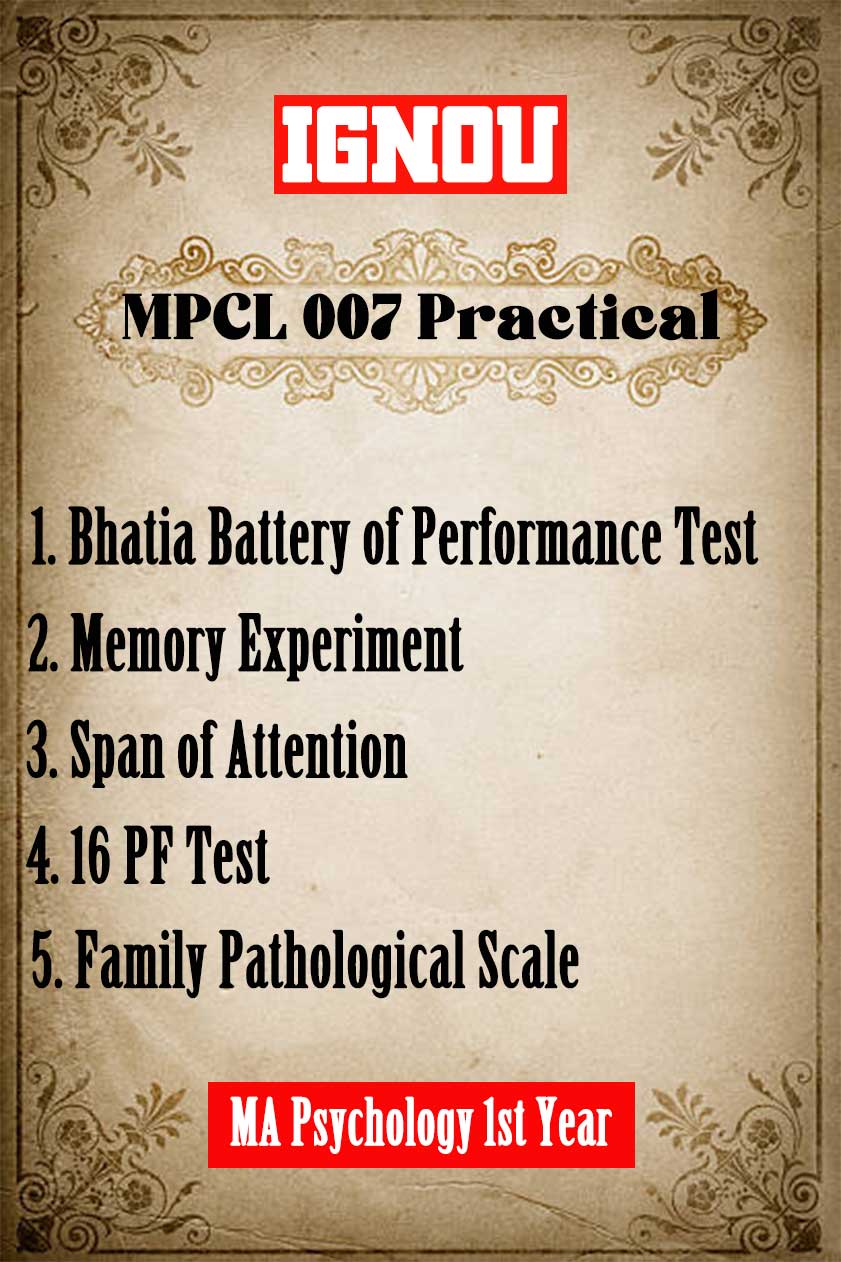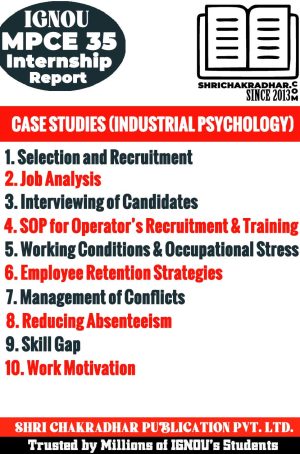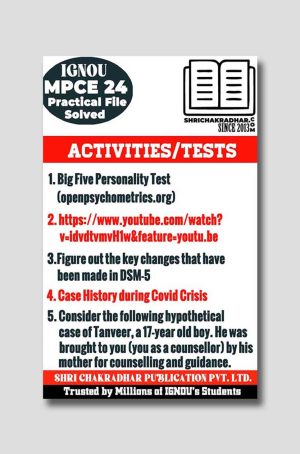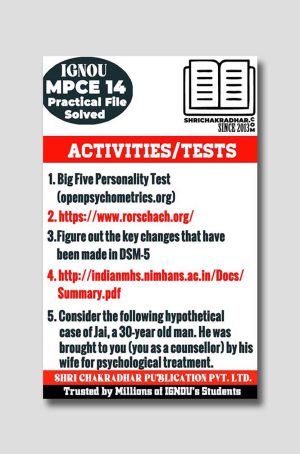Description
If you want to download the IGNOU MAPC 1st Year Practical File Pdf, you have come to the correct place, but first you need be aware of certain facts about IGNOU MPCL 7 Practical.
The learners must carry out the following practicals:
• Bhatia battery of Performance Test
You learned about intelligence in the course MPC-001: Cognitive Psychology. We regularly say things like, “she is highly clever,” or “he is a bright student” in our everyday lives. We build perceptions about people’s mental capacities based on their behaviours and specific achievements. Do you think it’s feasible to quantify someone’s intelligence? This is where psychologists started, with the purpose of establishing scientific techniques to evaluate how and what kind of mental ability a person possesses. However, assessing anything that cannot be seen instantly, such as any psychological attributes, is a difficult task. In the case of intelligence, the task was even more difficult. Because measuring anything requires a direct response to what is being measured. The intriguing aspect about intelligence is that each test attempting to examine it defines the idea in its own distinct manner.
Many IQ tests have been developed to date to account for a person’s cultural background. There are other examinations that are culturally neutral and applicable to everyone, regardless of culture. Culture-fair exams have little verbal content and test cultural and linguistic comprehension. In 1953, C. M. Bhatia created the Bhatia’s Battery of Performance Tests of Intelligence.
• Personality Testing (16 PF)
In the course MPC-003: Personality: Theories and Assessment, you learned about the concept of personality, many theories of personality, and several techniques to measuring the construct. We are aware of the numerous approaches and theories that have been developed to explore and describe the concept of personality. These theories are based on several models of human behavior. Each gives light on a different facet of personality, but not all of them.
The 16 Personality Factor Test was developed by British psychologist Raymond B.Cattell. Humans are distinguished from one another by a common structure, according to Cattell. This structure can be determined experimentally. He discovered the comparable structures by employing a statistical technique called as factor analysis. He identified 16 primary or source qualities. The source attributes are consistent and are thought to be the foundation of personality.
Aside from this, a variety of surface attributes emerge from the interaction of source features. Cattell described the source characteristics as opposing tendencies. To assess personality, Cattell developed the Sixteen Personality Factor Questionnaire (16 PF). This exam is now extensively used by psychologists.
The test was first issued in 1949 and modified in 1956 and 1962. The fourth version was released in five distinct editions between 1967 and 1969. The fifth edition of 16 PF was released in 1993. PF is an abbreviation for ‘Personality Factors,’ and there are sixteen of them, hence the name 16 PF. These 16 attributes are the most essential source features. Cattell’s thesis states that every human possesses a degree of each of the sixteen characteristics mentioned below (Cattell also uses the word factors).
• Social Behaviour Test (Vineland Social Maturity Scale)
You learned about social competence in MPC-004: Advanced Social Psychology. Learning how to interact effectively with acquaintances, friends, and intimate relationships is fundamental to social maturity. It also requires learning to value and respect those in positions of authority, whether civic, parental, employer, or spiritual. It is a measure of a person’s ability to function in diverse situations.
The Vineland Social Maturity Scale was developed by American psychologist Edger Arnold Doll (1953). The exam measures communication abilities, general self-help abilities, mobility abilities, occupational skills, self-direction, self-help eating, self-help dressing, and sociability abilities.
The examination is administered to the child during an interview with a parent or another person familiar with the person being evaluated. From infancy to eighteen years, it examines social competence, self-help abilities, and adaptive behavior. It is used to plan therapy and/or specialized instruction for those who have intellectual challenges or emotional issues. The Vineland scale has 89 elements and may be used from infancy until the age of 18. The following skills are assessed: daily living skills (general self-help, eating, dressing); communication (listening, speaking, writing); motor skills (fine and gross, including locomotion); socialisation (interpersonal interactions, play and leisure, and coping skills); occupational skills; and self-direction. The exam is not timed and lasts between 20 and 30 minutes.
• Family Pathological Scale
You learned about the impacts of dysfunctional homes in MPC-002: Life Span Development. The family, as you are aware, is the most important social unit in any society. In India, the family, rather than the individual, has been seen as the unit of the social order. The Indian family embodies the socio-cultural fabric of Indian society, as well as its philosophy and values (Sethi, 1989).
The scale was developed by Vimala Veeraraghavan and Archana Dogra (2000). The family pathology scale assesses the extent to which family members engage in maladaptive behavior in their interactions with one another, such as between spouses and between parents and children. A total of 100 statements were constructed, with 1 representing ‘low/no family pathology’ (‘Never’ response), 2 suggesting ‘medium family pathology’ (‘occasional’ answer), and 3 indicating ‘severe family pathology’ (most often response). The 100-item questionnaire was given to 25 clinical psychologists and 25 psychiatrists. The judges were asked to rate each item’s likelihood of family dysfunction on a three-point scale: “highly suggestive,” “somewhat suggestive,” and “not at all suggestive.” Only items with the same evaluation among all 50 experts were chosen using the internal consistency approach. Second, items with a rating of 1 indicated weak family pathology and ones with a rating of 2 indicated strong family pathology differed by two points. Only items that met the above two criteria were chosen and included in the final family pathology scale. Thus, the scale has 42 items to which the participant must respond with’most frequently,’ ‘sometimes,’ or ‘never.’ These were then administered to 300 married couples from the general population (N=600) and 100 couples from the mental (pathological) population (N=200), with the reliability and validity evaluated.
• Sociometry
You learned about social interaction in MPC-004: Advanced Social Psychology. The sociometry technique is used in the sociometry practicum. The name sociometry (created in 1951 by Jacob Levy Moreno) is derived from the Latin words “socius” (social) and “metrum” (meter) (measure). As a result, the terms imply that sociometry is a technique for assessing the degree of similarity between persons. Measuring the degree of relatedness or affiliation may help not only analyze the degree of cohesiveness among members of a group, work team, class, or organization, but it can also help bring about positive change and essential interventions. Sociometry may also help organizations analyze, examine, and evaluate their own dynamics, which can help bridge communication gaps and reduce conflict. It can also help determine which areas or groups require therapy or training. It is a statistic that evaluates how individuals connect with one another when working together toward a similar goal (Creswell in Moreno, 1960, p. 140). Moreno (1953, pp. 15-16) described sociometry as “the mathematical study of psychological features of populations, experimental technique, and discoveries obtained through the use of quantitative methods.”
Sociometry may be used as a scale to help people make decisions while also creating interpersonal relationships. It is a way of measuring in which at least (minimum) a group of 5-6 members is requested to select or select members of the same group based on specified criteria, such as everyone in the group being able to make selections and explain why the choices were made. These choices provide a description of the networks inside the group. A sociogram is constructed by using these judgments or preferences to create a visualization of those networks, comparable to a map. The sociogram data can also be represented as a table or matrix of each individual’s choices. A sociometric matrix is a table like this.
• Problem Behaviour Checklist
The present exam is focused on the topic of child behavior that you learned in the MPC-002: Life Span Development course. The problem behavior checklist was developed by Vimla Veeraraghavan and Archana Dogra (2003) to identify emotional and behavioral difficulties in youngsters. A total of 100 items were generated in the form of symptoms that had to be assessed on a three-point scale, with 1 indicating ‘no,’ 2 suggesting ‘average,’ and 3 indicating ‘high’ issue behavior, respectively. Individual diagnostic criteria for emotional, conduct, and combined conduct and emotion disorders were included in ICD-10. This 100-item set was given to 25 psychologists and 25 psychiatrists. Only items with the same evaluation among all 50 experts were chosen using the internal consistency approach. Using this approach, 58 items were picked from a total of 100. As a result, the scale has 58 questions to which parents must respond, with three answer categories: “most often,” “sometimes,” and “never.” These were then administered to 300 married couples from the general population (N=600) and 100 couples from the psychiatric (pathological) population (N=200), and the reliability and validity were determined.
• Span of Attention Experiment
Perception was introduced to you in MPC-001: Cognitive Psychology. Perception is a cognitive process that involves the meaningful interpretation and organization of stimuli. The phrase ‘Span of attention’ or ‘Span of perception’ refers to the maximum number of fundamental objects accurately recognized in a single brief presentation (Woodworth & Schlosberg, 1954).
In this discipline, Jevons (1871) was a pioneer. When the nature of a large number of randomly given stimulus items is the same, a person’s span of attention refers to the highest number of things or objects perceived by him. Gestalt psychologists have shown that human brains tend to absorb objects in their whole. When it can’t understand the whole, it resorts to parts rather than smaller wholes. When we see the phrase PSYCHOLOGY, we usually glance at this letter grouping as well as the initial few letters before reading the word. It’s worth noticing that the word is successfully recognized even if a letter in the center, such as “o,” is missing. This blindness to typographical errors is known as proof reader’s illusion.
A tachistoscope is used to measure the duration of visual perception. It is a gadget that displays a brief presentation of the stimuli to the participant.
• Memory Experiment
You must have understood the concept of Memory and the many types of memory in the MPC-001: Cognitive Psychology course. In 1885, Ebbinghaus showed that the effects of memory might be examined more pragmatically by using meaningless syllables (i.e., meaning less words like- mus, duv, tun). He observed that if participants were given a list of words to learn and then asked to recall them after a set length of time, they could recall nonsensical syllables more effectively and quickly than meaningful sentences. He was then questioned by Bartlett (1932), who argued that not only nonsensical syllables effect memory, but also cognitive, social, and experimental environment, and that these aspects should be considered when judging memory. Other ways of evaluating memory were also developed. Experiments using a memory drum are currently regarded as one of the most essential methods for assessing memory. A memory drum is a cylindrical device that may be rotated clockwise. It is simply a mechanical gadget that displays syllables or sentences serially over a specified period of time and at predetermined intervals. You will do any memory-based experiment using a memory drum or other instrument.
MPC-002: Life Span Development taught you about the effects of dysfunctional families. As you are aware, the family is the most important social unit in any culture. In India, the family, not the individual, has been seen as the unit of social order. The Indian family symbolizes Indian society’s sociocultural fabric, as well as its philosophy and ideals (Sethi, 1989).
Vimala Veeraraghavan and Archana Dogra created the scale (2000). The family pathology scale measures the amount to which family members participate in maladaptive behavior while interacting with one another, such as spouses and parents and children. A total of 100 statements were created, with one representing ‘low/no family pathology’ (‘Never’ response), two representing’medium family pathology’ (‘occasional’ response), and three representing’severe family pathology’ (‘Severe’ reaction) (most often response). 25 clinical psychologists and 25 psychiatrists completed the 100-item questionnaire. On a three-point scale, the judges were asked to score each item’s likelihood of family dysfunction as “very suggestive,” “slightly suggestive,” or “not at all suggestive.” Using the internal consistency technique, only items with the same rating among all 50 experts were picked. Second, items with a rating of 1 suggested weak family pathology, while those with a rating of 2 indicated substantial family pathology. Only items that matched the two criteria listed above were chosen and included in the final family pathology scale. As a result, the scale has 42 items to which the participant must reply “most frequently,” “occasionally,” or “never.” These were then given to 300 married couples from the general population (N=600) and 100 couples from the mental (pathological) population (N=200), and their reliability and validity were assessed.







Reviews
There are no reviews yet.